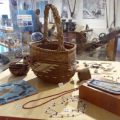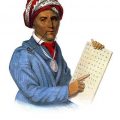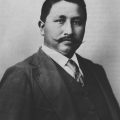
In 1669, the impact of the European invasion was being felt by Indian nations throughout North America. The European explorers were attempting to discover what they viewed as a wilderness, following Indian trails with Indian guides, and ignoring any possibility of Indian claims to the land. European missionaries sought to convert Indians to Christianity, ignoring the existence of Indian religions. Briefly described below are a few of the Indian events of 1669.
European Exploration
While the Europeans viewed North American as an unexplored continent, it has been well explored by Native Americans whose trails crossed the continent and whose stories told of the many geographic and geologic wonders unknown to the Europeans. The European ideas of North American geography seemed to be based more on fantasy than reality.
In Virginia, the governor of the English colony at Jamestown believed that the Pacific Ocean was only two weeks march west of the colony. He organized a group of 200 men to find the “East India Sea,” but the project was cancelled at the last minute because of weather conditions.
Morgan Jones, a Welsh cleric, claimed to have been captured by Tuscarora Indians in South Carolina. While bemoaning his fate out loud in his native Welsh, a Doag war captain came over to him and spoke in the same language. Speaking in this ancient British tongue, the Doag warrior assured him that his life was to be spared. Jones was ransomed by the Doag, went with them to their village, and claimed to have spent four months preaching to them in Welsh.
There were a number of Europeans who believed that some Indian tribes were descendants of the Welsh prince Madoc who supposedly settled on this continent in 1170 after fleeing from civil wars in Wales. There was an alternative hypothesis which viewed the Welsh-speaking Doag as the descendants of the lost colony of Roanoke.
A French expedition under the leadership of René-Robert Cavelier de La Salle set out to find the Ohio River. La Salle believed that this river flowed west and connected with the sea and then to China. The expedition left Montreal in seven canoes with 21 men. They were guided by two canoes of Seneca. With the expedition were two Sulpician priests and their interpreter—a Dutchman who spoke Iroquois but very little French. The priests were skeptical of La Salle’s claim to be fluent in Iroquois and when they arrived at the Seneca village, they found that La Salle did not speak Iroquois and that the Seneca were at war with the tribes in the Ohio valley. At this time, La Salle became ill and returned to Montreal.
Land Claim
The English adopted the concept of vacuum domicilium which meant that if they felt that the lands were “vacant”—lacking land development (meaning fenced fields) and permanent structures (meaning English-style buildings)—then they could be occupied and possessed without any concern for actual Indian ownership or use of the land. From the English viewpoint, only land that is tilled, fenced, and built upon was owned. While surplus Indian crops were important for English survival, the English still viewed the Indians as nomadic hunters who therefore did not own the land.
In New York, English families who were squatting on Matinecock land pressed their claims for land ownership. The Governor told them to present proof that they had purchased the lands from the Indians or cease pressing their claims. In his book Native American Place Names in New York City, Robert Steven Grumet reports:
“The Hempstead settlers ignored the governor, and continued their campaign to acquire the Matinecock lands. The English repeatedly turned their cattle loose in the Native gardens and harassed the Matinecock in many other ways.”
Christian Missionaries
Europeans brought with them a great religious intolerance. Missionaries attempted to Christianize Indians and to prohibit and even punish many aspects of Indian spiritual life.
In Wisconsin, the Jesuits established the mission of St. Francis Xavier on the Oconto River. The mission served the Menominee and a mixed village of Sauk, Fox, Potawatomi, and Winnebago.
In Saskatchewan, Jesuit Father Dablon tried to convert the Plains Cree. However, they were a nomadic people which made it difficult to convert them.
Intertribal Conflicts
In New York, a war party of Mahican, Pocumtuc, and Massachusett under the leadership the Massachusett sachem Chickataubut invaded Mohawk territory and attack Caughnawaga. The Mohawk’s Iroquois allies came to their aid and the invading war party was driven back. The Mahican were then totally subdued by the Mohawk and ceased to be an independent nation. The Mahican now had to obtain prior approval from the Mohawk council for all major community decisions.
In Maryland, the Susquehannock, at the invitation of the English colonists, waged war against the Wicomiss. The Wicomiss who were captured were sold to the colonists who exported them to the Barbados to be sold as slaves. In his book Historic Contact: Indian People and Colonists in Today’s Northeastern United States in the Sixteenth Through Eighteenth Centuries, archaeologist Robert Grumet reports:
“Their community scattered, the few Wicomisse people avoiding capture settled in nearby Indian communities or moved elsewhere.”
In the Great Lakes area, the Sioux sent ambassadors to the Ottawa. However, the Ottawa under the leadership of Sinago killed and ate the ambassadors in spite of having smoked the pipe with them. Later, the Sioux defeated the Ottawa, captured Sinago, and tortured him to death.
In New Mexico, the Apache were regularly raiding both Spanish settlements and the Pueblos. Fray Juan Bernal of Santo Domingo writes:
“…the whole land is at war with the widespread heathen nation of Apache Indians, who kill all the Christian Indians they can find and encounter.”
Dance
In Connecticut, a great many Indians gathered at a Pequot village under Robin Cassacinamon for a dance. Among those attending were the Mohegan sachem Uncas, the Niantic sachem Ninigret, and the Pequot sachem Wequash Cook. The English believed the gathering to be a conspiracy against them and sent a group of soldiers into the gathering. They demanded that Cassacinamon seize Ninigret so that he could be questioned. Cassacinamon negotiated a peaceful solution in which the soldiers were paid 20 fathoms of wampum to leave the village.
Towns and Villages
In Pennsylvania, the Susquehannock built a new town at the Oscar Leibhart site (36YO9). The town covers a little more than 5 acres and had a population of about 1,200.
In Missouri, the Osage established a village on a hill overlooking the Osage River near the present-day town of Lamar.
Population Decrease
In Virginia, a census of the Powhatan found slightly more than 2,000 people. This was down from 13,000 sixty years earlier. Archaeologist E. Randolph Turner, in his chapter in Cultures in Contact: The European Impact on Native Cultural Institutions in Eastern North America, A.D. 1000-1800, reports:
“The rapid collapse of the Powhatan chiefdom was a direct result of large-scale warfare with the English.”




Leave a Reply